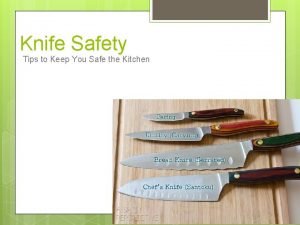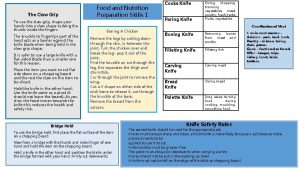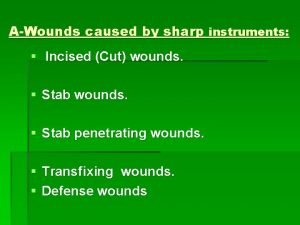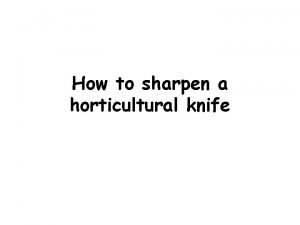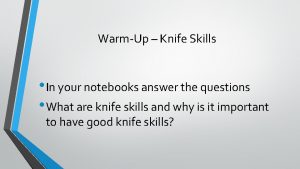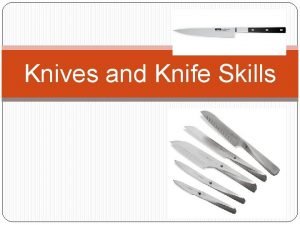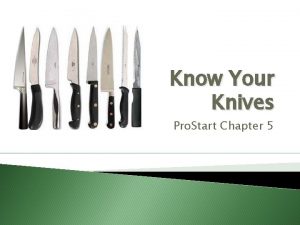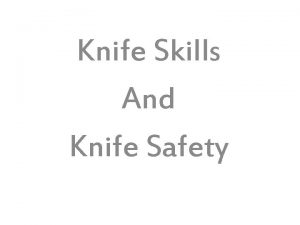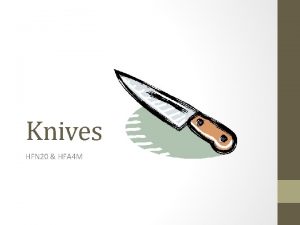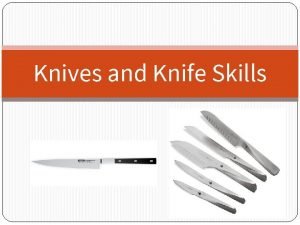TFJ 3 C Ms Mulligan Smith Chefs Knife






















- Slides: 22

TFJ 3 C Ms. Mulligan Smith

Chef’s Knife Sometimes called a French knife large, wedge shaped blade chop, dice, mince

Paring Knife Short blade, fine work Peels and cuts fruits and vegetable

Serrated Knife Cuts through foods with a hard exterior and a soft interior Serrated blade Easily cuts through bread, tomatoes, cakes

Anatomy of the Knife • • • A: Tip – Scoring shallow cuts B: Spine – Thicker than blade C: Bolster – Gives the blade weight D: Heel – Keeps fingers away from blade E: Rivets: Secure handle to blade F: Handle: Should be strong and easy to grip G: Tang – Helps with balance The best knives are forged from a single piece of steel that runs the entire length of the knife. Full-tang construction offers better balance, making the knife easier to use.

How to hold a knife • Hand holding knife • Pinch blade with thumb and pointer finger • Wrap the rest of the fingers around the handle • Provides for extra control over the blade. • Use a rocking motion

How to hold a knife Hand holding food Your non-knife hand is called your "guiding hand, " and its job is to hold the food to keep it from sliding around on the cutting board. You need to keep those fingertips tucked safely away, while still being able to firmly hold the food. “Claw’, keep fingers curled back Use your middle finger as a guide

The 10 Commandments of Knife Safety Thou shalt always cut away from yourself Thou shalt use an appropriate firmly fixed, cutting surface Thou shalt keep your knives sharp Thou shalt use the right knife for the right job Thou shalt hand wash your knives Thou shalt always hold a knife by the handle Thou shalt always carry and store knives blade down Thou shalt store knives with their blade covered Thou shalt never wash knives in the dishwasher Thou shalt never grab for a falling knife

Knife Safety Tips Always use a cutting board Place a towel under the cutting board to keep it from sliding Choose the proper size and type of knife for the job. Always cut away from the body Curl fingers away from blade when holding food being cut Wash them separately

Different Types of Cuts Large pieces of vegetables take longer to cook than smaller ones Consistent cutting technique ensures your food is cooked to a uniform degree of doneness Chop – To cut food into fine, medium or coarse irregular pieces Dice - To cut food into uniform pieces. Mince – To chop food into tiny, irregular pieces. Slice – To cut food into flat, thin pieces. Julienne – To cut food into thin, match like sticks.

Slice

Mince

Large Dice The large dice is a culinary knife cut measuring ¾ inch × ¾ inch.

Batonnet The batonnet measures ½ inch × 2½-3 inches. It is also the starting point for another cut, the medium dice.

Medium Dice The medium dice measures ½ inch × ½ inch.

Allumette Measuring ¼ inch × 2½-3 inches, the allumette is sometimes referred to as the "matchstick cut. " It's also the starting point for the small dice.

Small Dice The small dice measures ¼ inch × ¼ inch and is produced by slicing the allumette into ¼ inch sections.

Julienne The julienne cut measures 1/8 inch × 2½ inches.

Brunoise The brunoise knife cut measures 1/8 inch × 1/8 inch.

Fine Julienne • The fine julienne knife cut measures 1/16 inch × 2 inches. It's also the starting point for the fine brunoise cut.

Fine Brunoise The fine brunoise knife cut (pronounced BROONwahz) measures 1/16 inch × 1/16 inch.

Chiffonade Cutting herbs and leafy green vegetables into long, thin strips Common with spinach, sage and basil Rag-like strips
 Famous chefs in history
Famous chefs in history Grant mulligan
Grant mulligan What is a garnish?
What is a garnish? Latin word for camera
Latin word for camera Knife privilege escalation
Knife privilege escalation Knife safety tips
Knife safety tips Gonna buy me a knife with a blade ten inches long
Gonna buy me a knife with a blade ten inches long The dagger soliloquy
The dagger soliloquy Claw grip knife
Claw grip knife Clasp knife response
Clasp knife response Incised cut
Incised cut Fetotome
Fetotome Horticultural knife
Horticultural knife Pramopexole
Pramopexole Prone jackknife
Prone jackknife Kitchen knife safety poster
Kitchen knife safety poster Basic knife cuts chart
Basic knife cuts chart Knife construction
Knife construction Meret oppenheim
Meret oppenheim Private first class richard reiben
Private first class richard reiben Know your knives worksheet
Know your knives worksheet Kitakaze knife
Kitakaze knife Trojan stanley knife
Trojan stanley knife





